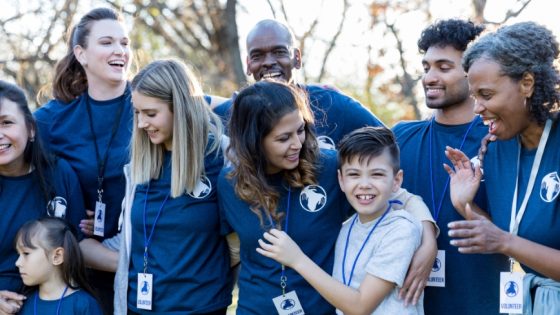Volunteers are the backbone of the nonprofit sector. The essence of philanthropy is “voluntary action for the public good” and our nonprofits were founded with the resources and ingenuity of volunteers to make the world a better place. Today, a lot of nonprofits have professionalized their programs, hired highly qualified staff and some have moved away from their founding involvement of engaging well-meaning volunteers.
With specialized staff, client confidentiality and complex systems, it can be difficult to connect an enthusiastic volunteer with some of the work demands that now exist. Some parts of the nonprofit sector are significantly more challenged to identify volunteer opportunities within their work, especially in the mental health sector and those serving marginalized communities.
Despite the challenges, a volunteer engagement program can reap amazing benefits if created and managed effectively. Nonprofits should be thoughtful about how they spend their time identifying and executing an effective volunteer engagement program. It’s important to make sure that a volunteer’s time is used wisely not only for the individual giving their time but also for the nonprofit who is engaging them. First, it’s important to consider the motivations before creating a volunteer engagement program and then determine the best strategy to put those folks to work.
Understanding Volunteer Engagement and its Value
The first thing a nonprofit should consider is the “why” of establishing a volunteer program. Volunteer time is a valuable resource that can save nonprofits lots of money that might otherwise be spent on payroll. Consider first that your nonprofit is financially stable and seeking to grow. Creating a volunteer engagement program is not a solution to financial difficulties or reducing qualified staff from your payroll. It is more beneficial to consider how volunteers will enhance your mission instead of imagining it as a financial stopgap.
Organizational Capacity and Strategy
Providing volunteer opportunities can seriously and thoughtfully engage volunteers in the direct work of your nonprofit mission. One of the most beneficial items when it comes to volunteer engagement is that volunteers are typically some of the most likely untapped philanthropic sources of revenue for an organization. If an individual is giving you their time, they may also have a passion and a willingness to give their financial resources.
From the nonprofit perspective, consider the internal or staffing capacity to engage additional volunteers. Which staff member or members are responsible for executing the volunteer engagement activities? Volunteer time is valuable and should not be squandered by not having the right person managing your program.
Moreover, make sure your nonprofit is approaching a volunteer program from a place of enhancing programs and determine who will lead the strategy and execution of such a program. Now you’re ready to start thinking about the best way to engage volunteers.
Developing a Volunteer Engagement Strategy
Engagement involves placing volunteers in roles that match their skills and interests and constant communication. Keeping volunteers engaged requires understanding their motivations and providing fulfilling experiences. Engaged volunteers can become critical to an organization’s reputation and success, as they become and act as advocates for your cause. Consider the following actions in establishing a volunteer engagement strategy.
- Determine your Organizational Needs: What are the roles and responsibilities where a volunteer can serve? Which programs can be enhanced with volunteer support?
- Understand Volunteers and Goals: Gather information about volunteers’ interests and skills during sign-up, conversations, and training sessions. Use this information to align volunteers with suitable roles.
- Reinforce with Communication: Maintain open communication channels to remind volunteers of events, gather feedback, and create a sense of community. Treat your volunteers as a distinct segment within your communication channel. This group is interested in giving their time and money and messaging should revolve around their heightened involvement.
- Use the Right Tools: Implement tools that simplify registration, manage communication, and gather data to support volunteer engagement. Most donor databases have this functionality.
- Focus on Onboarding: Create a strong onboarding process that introduces volunteers to the organization’s mission, opportunities, and goals.
- Define Long-Term Engagement and Measure Volunteer Engagement: Define success metrics, such as frequency of volunteering, attendance rates, retention rates, and donations by volunteers. Identify what successful long-term engagement looks like and develop strategies to achieve it.
- Volunteer Engagement Ideas: Empower volunteers to recruit friends and host events. Implement formal recognition programs to show appreciation. Build relationships through conversations about interests and experiences. Provide training and mentoring to support volunteer development.
Looking Ahead: Future Directions for Volunteer Engagement
As nonprofits evolve and professionalize, the role of volunteers remains indispensable in advancing our missions for the greater good. Beyond their invaluable support in day-to-day operations, volunteers embody our shared commitment to community and social impact. By strategically engaging volunteers, nonprofits not only harness additional resources and expertise but also cultivate passionate advocates who amplify our messages and extend our reach far beyond what our staff alone could achieve.
It’s crucial for organizations to approach volunteer engagement with intentionality, aligning roles with volunteers’ skills and passions, and fostering meaningful connections that inspire long-term commitment. Remember, effective volunteer programs are not just about filling gaps; they’re about building sustainable relationships that deepen community impact over time.
As you navigate the complexities of modern nonprofit management, consider your volunteer program not only as a logistical necessity but as a cornerstone of your organization’s legacy. By investing in volunteer engagement thoughtfully and strategically, you’re not only ensuring operational success but also nurturing a community of champions who share your vision for a better world.
Together, let’s continue to innovate and empower through volunteerism, knowing that each volunteer’s contribution is a powerful step towards realizing our collective aspirations for a brighter future.






